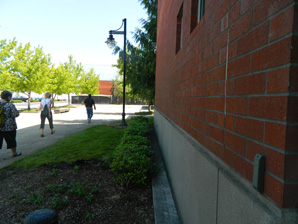A Plan to Reduce Illness – and Pesticides – in Schools
 |
|
A concrete barrier around the perimeter of a school building prevents vegetation from touching the structure, denying a source of harborage to pests. Source: IPM Institute of North America. |
In the last decade, studies have shown that if pests such as mice and roaches get established on school premises, they can lead to serious, long-term health issues and performance problems in children. School officials, meanwhile, face increasing requests from community members to consider environmental and health impacts associated with pesticides used in and around schools.
A team of experts is calling attention to this changing landscape and have released a plan blueprint to help school employees and caregivers keep pests from entering buildings and grounds.
“I’ve worked on this program in schools for over eight years,” said Lynn Rose, an environmental consultant and a member of the Northeast School Integrated Pest Management (IPM) Working Group. “Now we’ve distilled the best of our knowledge into a free, downloadable management and operations plan that anyone can set up in schools.”
The plan is an environmental management system based on ISO 14000, an industry standard for managing environmental issues within organizations.
The working group recently introduced the plan to schools in New York, Vermont, and Massachusetts. The Northeastern IPM Center at Cornell University funded the working group and the development of the plan, which can be used in every state. Officials can customize and enhance the plan to suit their individual needs. It could be set up at the school building level or at the district level.
Rose envisions that people who want to make schools safer will become champions of the plan. Health and childcare providers, facilities managers, community members, and school administrators have already expressed interest.
THE PLAN: DETERRENCE
At its most basic, a management and operations plan gives school personnel a policy, a comprehensive framework, and a standard set of protocols to manage pest issues before they develop into a crisis.
“Our plan builds upon the good things schools are already doing,” said Carol Westinghouse, president of Informed Green Solutions—an environmental advisory non-profit organization—and the co-chair of the Northeast School IPM Working Group. “It is very well-organized, so it is easy to use. Our goal is to get on top of prevention.”
A facilities manager could take steps such as weather-stripping doors, installing screens, and keeping surfaces clean. These activities can prevent pest entry, eliminate allergic reactions to stinging insects, discourage roaches, improve air quality, and reduce asthma.
PREVENTING A PEST CRISIS
“Crisis management is not prevention,” said Rose. She usually finds problems in schools such as cluttered storage, cardboard on the floor, and food left out without seals. “When mice and roaches begin to move in, people become afraid.”
“Often, school employees depend on hazardous products instead of prevention,” said Westinghouse. “Environmental issues affect school performance. Pest allergens are known to lead to asthma and absenteeism.”
IPM REDUCES PESTS AND HEALTH PROBLEMS
A national study of 937 children conducted by the Inner-City Asthma Study Group led by Wayne Morgan and published in the New England Journal of Medicine in 2004 evaluated the effectiveness of environmental interventions in the home. Both cockroach and dust-mite allergens were dramatically reduced using IPM practices.
Godfrey Nalyanya of North Carolina State University reported in 2009 that IPM can cut cockroach-related asthma triggers to insignificant levels in schools.
“Studies show that non-IPM schools have a higher incidence of pest infestation, higher pesticide residues on exposed surfaces, and higher pest control costs,” said Thomas Green, president of the IPM Institute of North America.
His organization recently coordinated a national survey at the school district level that shows school administrators where they stand in terms of safe pest management practices. Officials from the EPA and regional IPM Centers have expressed interest in the data to help them set priorities for needed action.
“Our goal is to establish integrated pest management in schools, much like they have protocols for food safety and security,” said Green.
OPPORTUNITIES FOR PESTS
In schools you find children sleeping on mats on the floor, Rose said, a problem when cleaning takes a back seat. In budget crunches, custodial services such as dusting are cut first. But pests can thrive in dusty environments, cluttered classrooms provide harborage for insects, and poor landscaping provides rodents and insects protected access into buildings.
“If the school community is not aware of IPM, custodial staff can find themselves burdened with managing pest problems, when it should not be their responsibility alone. It needs to be a team effort, supported by administrators and the school community,” said Rose.
To download the plan:
— by CHRIS GONZALES
The Northeastern IPM Center promotes integrated pest management for reducing risks to human health and the environment. If republishing our news, please acknowledge the source (“From Northeast IPM Insights”) along with a link to our website.
